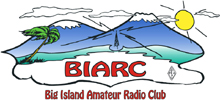BIARC Home
Club Information:
Officers
Committees
Members
Constitution
Bylaws
Constitution & Bylaws-PDF (Printable)
How to Join BIARC
Membership Booklet (PDF)
Activities:
Calendar of Events
Classes & Training
Presentation Archive
2021 ARES SET
Communication:
Newsletters
Repeaters
Nets
BIARC Listserve
ARES Information
Prowords
External Links:
Information
|
How do I get my amateur radio license?
Overview:
- The Federal Communications Commission (FCC) regulates the Amateur Radio Service, which is also known as "Ham Radio."
- Licensed Radio operators use the frequencies allocated to the "ham radio" bands. We are required to have a valid FCC license, and operate within the defined rules.
- Their is a $15 Testing Fee paid when taking the exam, and a $35 licensing fee paid to the FCC in order to get your license after passing the exam.
- When a license is issued, it is good for 10 years before renewal is required.
- There are currently 3 classes of licenses.
- Technician. After passing the technician exam, you can apply for your technician class license. This allows you to transmit on a defined subset of the Amateur Radio frequencies.
- General. Additional frequency privileges are granted when you hold a General Class license.
- Amateur Extra. These license holders have full access to all radio frequencies available in the Amateur Radio Service.
The ARRL is the national association for amateur radio. The ARRL operates as a 501(c)(3) non-profit organization under IRS rules. The ARRL and other amateur radio clubs and organizations around the US publish books, provide classes, and organize training and testing sessions.
Testing is handled by Volunteer Examiners. (VEs) A request to schedule a testing session may be sent to Doug Wilson, KH7DQ via email at douscelle@aol.com. Testing Sessions are often held on the same day and location as the Big Island Amateur Radio Club activities, and are also available at other locations and on-line.
Many classes and training resources are available for free both online and in person. The FCC testing fees are non-refundable. However, if you pass your technician exam you have the option to take the General and Amateur Extra exams at no additional cost if done in the same testing session.
The ARRL website is a great place to begin learning about amateur radio. The links below are a small sample of helpful resources online. The content under these links is not created or controlled by BIARC. It is meant to be a helpful resource to help you get started.
Step 1: Study Options:
- Purchase a book or study guide.
- Local Technician License Preparation Class:
A six-week course consisting of a class session each week, with the licensing exams given in the final week. People interested in this class should contact Doug Wilson, KH7DQ via email at douscelle@aol.com for specifics on the venue and schedules, and also to register.
- Ham Education Hawaii provides classes and Exams. Visit their Website at https://hameducationhi.org/
- Videos on Youtube:
Step 2: Practice Exams:
Practice exams simulate the 35 questions on the license test by randomly selecting questions in each of the various categories from the FCC's official question pool. You are presented with samples of the questions that may appear on the actual exams. Take these practice exams as often as you wish, until you are satisified with your ability to pass the test.
Step 3: Testing:
It does not matter where you take the test in the US. Your license will be good in all states, territories, and even when you are in certain foreign countries that have reciprocal license agreements in place with the US. License tests can be conducted online via video conference or in person.
Another good option to find testing sessions near you is to visit the ARRL Find an Amateur Radio License Exam Web Page
Step 4: Guides to Getting Started:
Buying Your First Ham Radio, Getting Started In Amateur Radio Part 2 (HamRadioConcepts)
How To Talk On Amateur (HAM) Radio, Good And Bad, Part 3 (HamRadioConcepts)
There are many great guides available on youtube.com that cover all aspects of the Amateur Radio Service, and provide information about all aspects of the hobby.
Additional Notes:
- The Amateur Radio Service, is regulated under Title 47 / Chapter I / Subchapter D / Part 97 of the Code of Federal Regulations.
- There are other radio services defined and regulated by the FCC, that are seperate from the Amateur Radio Service. These services use different rules and provide different capabilities then the Amateur Radio Service.
The Amateur Radio Service is the most flexable option. It allows access to many different bands and modes of communication. It also allows you to operate your transmitters with a wide variety of antennas, and use more transmitter output power than the other services described below:
-
CBRS – Citizens Band Radio Service (CB Radio)
-
FRS – Family Radio Service
-
22 channels (462 & 467 MHz UHF)
-
Used for short-range personal or family communication (e.g., hiking, camping)
-
No license required for FRS-only radios
-
GMRS – General Mobile Radio Service
-
MURS – Multi-Use Radio Service
-
CBRS (not to be confused with CB Radio) – Citizens Broadband Radio Service
-
3.5 GHz band, used mainly for broadband access and shared wireless networks
-
Requires coordination or licensing in some tiers
BIARC is a 501(c)(7) tax-exempt entity, supported by our members and volunteers. Please consider making a donation.
Note: BIARC donations are not tax deductable.
Except where noted, all original content Copyright © BIARC.net and Big Island Amateur Radio Club 2005 - 2025.
All rights reserved.
Big Island Amateur Radio Club. P. O. Box 1938, Hilo, HI 96721-1938.
|
